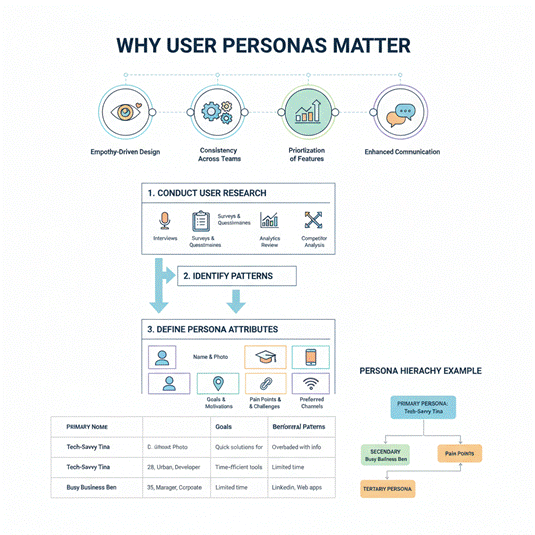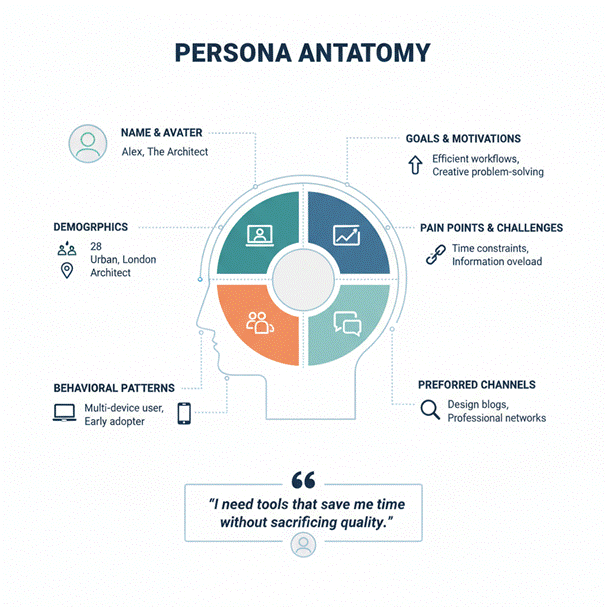In the ever-evolving world of digital experiences, one factor remains constant: understanding your users is the key to designing meaningful and engaging interfaces. A great product doesn’t just function well—it resonates with the people who use it. This is where user personas come into play.
User personas are fictional representations of your ideal users, created based on real data and research. They help designers, developers, and marketers align their strategies to meet the actual needs and behaviors of their target audience. Whether you’re working on a website, mobile app, or enterprise platform, crafting accurate user personas ensures that your design decisions are user-centered.
Why User Personas Matter in UX Design
When teams make decisions without clear insight into users, they often rely on assumptions, which can lead to poor experiences and high abandonment rates. Personas act as a north star, guiding design decisions with empathy and accuracy.
Here’s why they matter:
- Empathy-driven Design: Personas help teams see through the eyes of their users.
- Consistency Across Teams: Designers, developers, and marketers can reference a shared understanding of users.
- Prioritization of Features: Focus on what really matters to your core audience.
- Enhanced Communication: Stakeholders can discuss ideas with real user scenarios in mind.
At CuriosityTech.in, we’ve observed that teams that incorporate personas early in the UX process see faster adoption, better user satisfaction, and reduced redesign efforts.
Steps to Build Effective User Personas
Creating a user persona involves research, synthesis, and documentation. Let’s break it down:
1. Conduct User Research
Research is the foundation. Use a mix of qualitative and quantitative methods:
- Interviews: Talk to real users about their motivations, goals, and pain points.
- Surveys & Questionnaires: Gather demographic and behavioral data from a larger audience.
- Analytics Review: Identify patterns in how users interact with your product.
- Competitor Analysis: Understand how similar products are serving their audiences.
2. Identify Patterns
Once you collect your data, look for recurring behaviors, goals, and challenges. These patterns help in grouping users into segments, which become the basis of your personas.
3. Define Personal Attributes
Each persona should include:
- Name & Photo: Humanizes the persona.
- Demographics: Age, gender, location, education, job title.
- Goals & Motivations: What are they trying to achieve?
- Pain Points & Challenges: What obstacles do they face?
- Behavioral Patterns: Device usage, online habits, purchasing behavior.
- Preferred Channels: Where do they seek information or interact online?
Example Table for a Persona Hierarchy:

This table can evolve into a visual hierarchy diagram showing primary, secondary, and tertiary personas to help teams prioritize design efforts.
4. Craft Persona Narratives
A persona should tell a story. Describe a day in their life, their challenges, and interactions with your product. This narrative approach makes personas relatable, ensuring your team designs with empathy rather than assumptions.
5. Validate & Update
User personas are living documents. Continuously validate them with new research and user feedback. At CuriosityTech.in, we recommend reviewing personas quarterly to adapt to changing user behaviors and market trends.
Tips for Humanized Personas
- Avoid stereotypes; base everything on real data.
- Include emotional and psychological traits, not just demographics.
- Use visuals like avatars, quotes, and infographics to make personas memorable.
- Keep personas concise but informative, focusing on actionable insights.

This can be a visual anchor for presentations and workshops.
Integrating Personas into UX Design
Once personas are defined:
- Wireframing: Design interfaces keeping primary persona scenarios in mind.
- Content Strategy: Tailor messaging for persona motivations.
- Feature Prioritization: Focus on features that solve real problems.
- Testing: Use personas to create realistic test scenarios for usability testing.
By consistently referring back to personas, your team ensures every design choice is aligned with user needs.
Conclusion
Building user personas is more than just a UX exercise; it’s a strategic approach to creating digital experiences that truly resonate. When designers understand their users’ goals, challenges, and motivations, they can craft interfaces that are not only functional but also emotionally engaging.
At CuriosityTech.in, we emphasize the power of personas in every design project, ensuring that businesses build products that users love. The combination of thorough research, storytelling, and continuous validation helps teams create meaningful, user-centered designs that stand the test of time.
Suggested Tags
UX Design, User Personas, UX Research, User-Centered Design, CuriosityTech, Digital Experience, Persona Creation, Product Design, UX Best Practices, Design Thinking
Suggested Keywords
User Personas, UX Design 2025, Creating Personas, UX Research Methods, CuriosityTech UX, Designing for Users, UX Strategy, Persona Template, Digital Product Design


